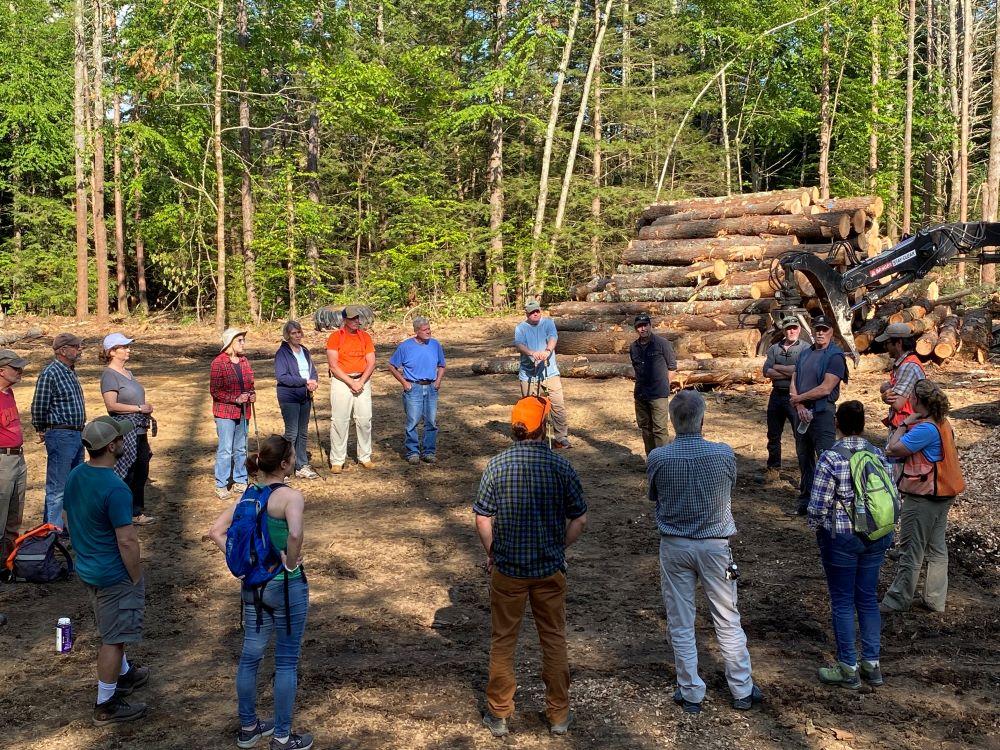Forest Society invites people to learn about careful forestry
- Tags:
- Forestry,
- Timber Harvesting,
- Education

Timber Harvest tour participants at log landing Lamprey River Forest Epping.
A recent tour of an active timber harvest at the Forest Society's 162-acre Lamprey River Forest provided an excellent opportunity to see the forestry underway, ask questions and learn more about how the property is being managed in accordance with a long-term forest management plan for the property. Residents of Epping, Conservation Commission members and the public joined project staff June 15, 2023 for a tour from 5 pm to 7 pm.
Foresty staff leading the tour included Forest Society Managing Forester, Wendy Weisiger, field forester Steven Junkin and consulting foresters, Charlie Moreno and Nick Lanzer from Moreno Foresty Consultants.
Participants hiked a loop through areas being cut to remove red pine affected by scale - an invasive insect. The logging crew from Day Brothers Logging have used stumps and brush as temporary bumpers to protect standing trees along skid trails. The thinning operation will regenerate a thick carpet of new white pine seedlings due to a second-year cone crop that will open this autumn 2023. Bare ground operation facilitates heavy pine regeneration where dry, sandy, or bare mineral soils are exposed to sunlight when there is a cone seed crop.
Foresters explained the relationship of timing the timber harvest with weather and seasonal considerations as well as the availability of the logging contractors to cut the trees.
Wildlife habitat considerations include creating stump piles from the access road clearing as durable brush piles for insects, birds, rodents and for larger mammal den sites. Corridors in the forest along skid trails provide hunting and foraging opportunities for raptors including hawks and owls as well as summer feeding opportunities for bats.

The dry sandy soil at the Lamprey River Forest grow white pine and hemlock as well as hardwoods including red and white oak and smaller areas of red maple, white birch, and aspen (poplar). Specimen trees of yellow birch and sugar maple are relatively few but are being retained as important trees in the species mix of the residual stand.
Charlie Moreno had also overseen the last timber harvest 20 years ago in 2003 after the Forest Society acquired the first part of the property in 2000. An additional tract was acquired in 2007. The openings and small group selection from that 2003 harvest have now regenerated a 20-year old forest of saplings and pole-size hardwoods.
The mechanized harvesting equipment using a feller-buncher allows the highly skilled crew of logging contractors at Day Brothers Logging to maneuver between future crop trees with surgical precision to selectively remove trees marked for removal without damaging stems or crowns of the residual crop trees.
Forest Society field forester Steve Junkin created a GIS story map with photos here.
Steve explains specific objectives of the timber harvest with the primary goal to remove diseased red pines while logs remain viable for forest products and to add light to release the advanced regenration from the previous harvest.
Steve explains: "We are picking up where we left off from the last harvest on the property in 2003 also administered by Charlie Moreno. That forest management project was a success having regenerated oak (white and red), hickory, black birch and white pine in addition to providing more space for the remaining trees to grow and thrive. The younger trees are ready for a release. Thinning some overstory trees that are casting shade will achieve this as well as small group openings."
"Other objectives include salvaging dying red pine that is succumbing to the red pine scale. We hope for a good seed year from both oak and pine two species that often take some chance and luck to successfully regenerate. White pine should have an excellent crop and operating during the growing season will ensure a scarified soil seed bed, prepping the soil for germination from the seeds this early fall."
"Because this is a whole tree operation we expect excellent 'scarification' to regenerate white pine. This harvest will diversify the age structure of the property by creating some large gaps where the planted red pine once grew and will ensure adequate overstory and superstory trees to remain adding verticle structure to the property. Also species diversity will be enhanced. Underrepresented tree and shrub species will be encouraged and protected during the operation."
There are two access points to the harvest area. One from the original point of entry off Prescott Road and another from Olde Bridge Lane which will be a newly created access into the property.
We are proud to share and teach about the careful forestry operations which help the Forest Society to achieve both timber and non-timber property management goals annually on portions of some of the 200 properties totalling 60,000 acres statewide owned by The Forest Society. When neighbors in local communities have a chance to tour an active timber harvest to ask questions to learn which trees are selected for cutting and which trees are favored to grow as future crop trees it is both a teachable moment and an imporant community engagement opportunity. We are grateful to the foresters at Moreno Forestry Consultants, Day Brothers Logging and to those who joined us for the evening tour.
